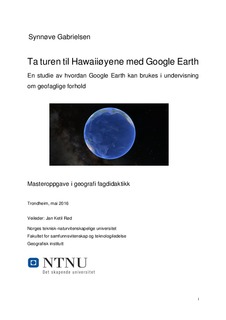| dc.description.abstract | This is a didactic thesis regarding use of Google Earth in education. Google Earth is a user friendly an immersive visualization tool, which provides the pupil with a large number of ways to interact with geographic information. Google Earth is a popular teaching tool in Geography in Norwegian schools. However, it is hard to find any documentation of how Norwegian pupils use Google Earth for their training and learning. This thesis presents an implemented learning application on the geoscientific characteristics of the Islands of Hawaii used in an upper secondary school class. The learning application is based on Google Earth and the thesis applies action research to evaluate and discus pupils’ attitudes and perceived learning effect from using it.
The aim of this study is to address how Google Earth can be used as a visualization tool that facilitates learning geoscience characteristics. In answering that question, three issues have been examined, i.e.: (1) Do pupils understand geomorphological processes when they use Google Earth? (2) To what extend can learning with Google Earth fulfil relevant curricular goals in “Geosciences”? and (3) How to facilitate active learning with Google Earth?
These issues were answered by conducting participant observation, a knowledge test, a survey and interviews. The use of both qualitative and quantitative methods implies a triangular research design. Furthermore, the data retrieved were analysed with open coding.
In accordance with Blooms taxonomy, the results of the knowledge test show that pupils understand the most essential geomorphological processes. In addition, the implemented learning application based on Google Earth meet several curricular goals, such as pupils own presentations where they interacted with displayed information in Google Earth. An important component in facilitating active learning with Google Earth is to let the pupils make use of the tool themselves. In the implemented learning example, pupils worked collaboratively in small groups with provided tasks where use of Google Earth was necessary to find answers. The tasks had sufficient details to make sure that the pupils knew what to search for and why. To help pupils maximising their use of Google Earth, an introduction of some of the key functions would have been beneficial.
Based on the evaluation and reflection of the implemented learning application, this study demonstrates how Google Earth can work as an appropriate tool that facilitates exploratory learning. | nb_NO |
